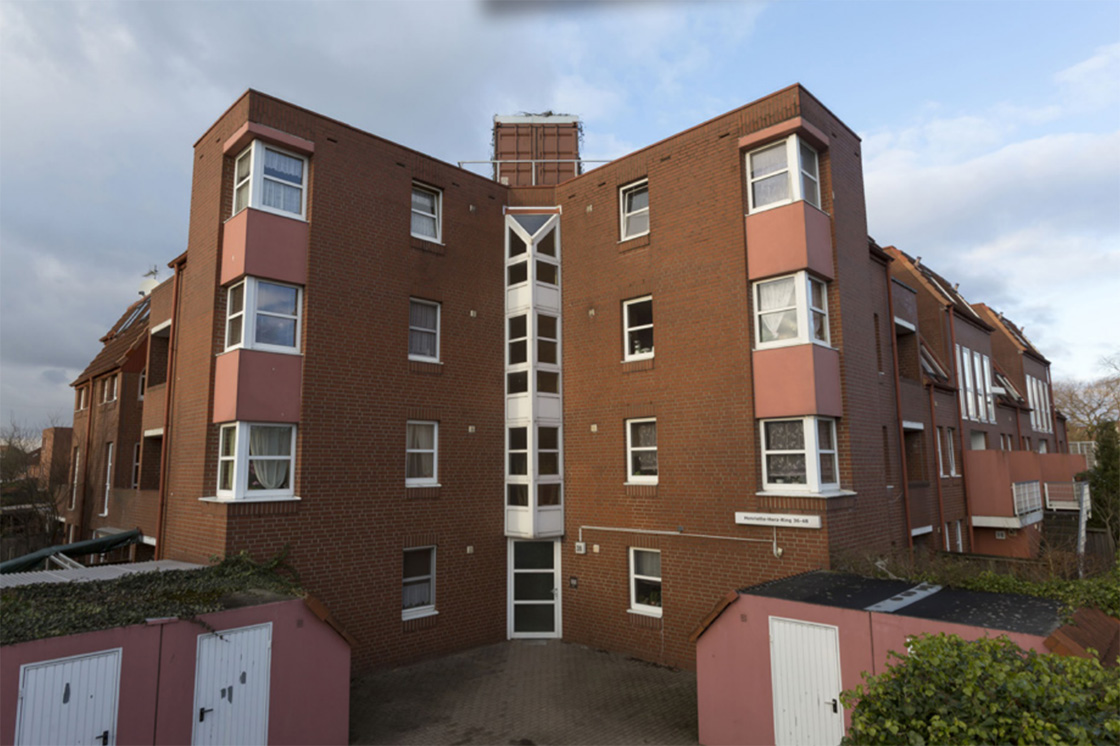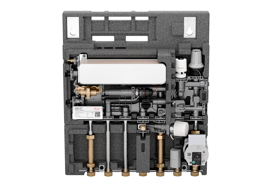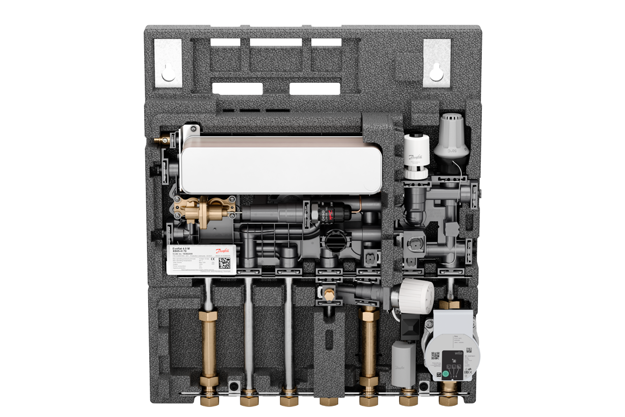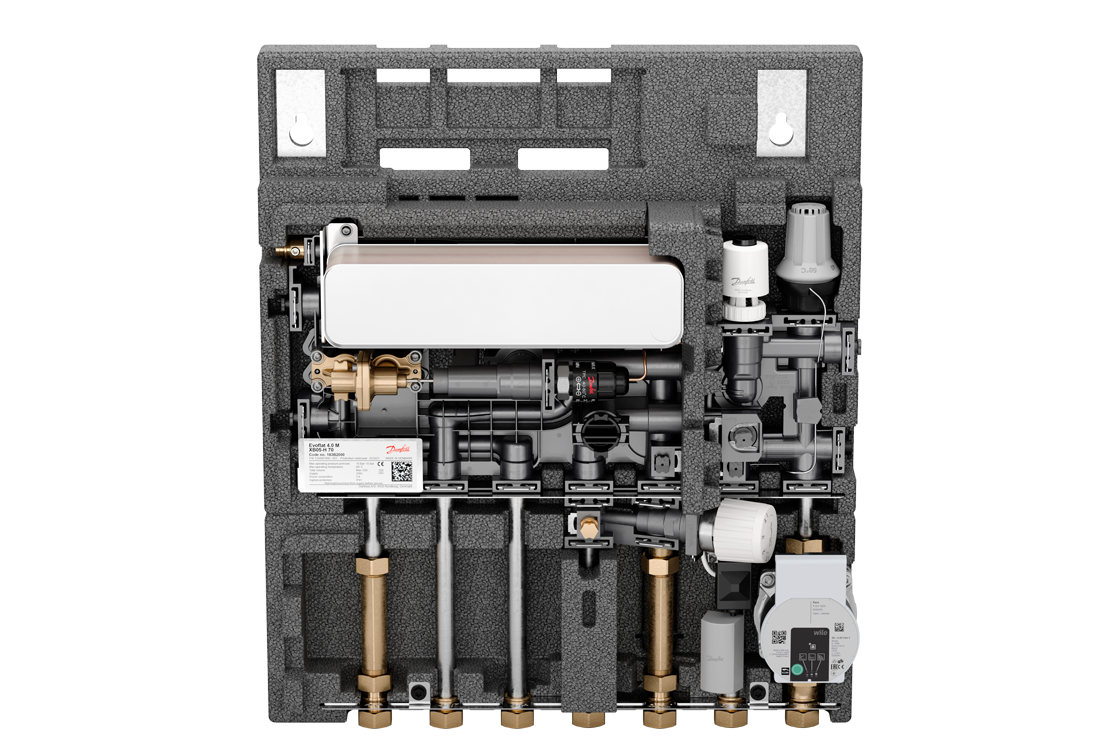
30-year-old gas boilers replaced by flat stations
Hamburg, Germany
Visitors to Hamburg’s Henriette-Herz-Ring who let their gaze drift upward will discover two shipping containers on the roof of the apartment building. They are the visible result of an innovative planning initiative to replace inefficient gas boilers with Danfoss flat stations. The highlight of this renovation: residents did not have to vacate their apartments.
The property
The 28/30 apartments in each of the buildings were built approximately 30 years ago as part of a council housing initiative, and were equipped with gas-heated combo-boilers for heating and domestic hot water. Because of the moist subsoil, the building owner at the time decided not to construct a basement for safety reasons. Now the buildings are owned by the Meravis Corporate Group, a national real estate service provider.
The renovation
The original plan for the overdue refurbishment of the heating system was to equip all apartments with new condensing gas boilers. However, this proposal was vetoed by the chimney sweep, who rejected the notion of connecting up to three heaters to a single chimney. Next, licensed graduate engineer Claus Schellhorn, from the company of the same name, was awarded the contract to develop a suitable alternative for the heating system.
The concept
Every apartment would be equipped with a decentralized flat station supplying the apartment with heat and domestic hot water. The central heat supply would be courtesy of a condensing gas boiler by Brötje - housed in a shipping container on the roof. Claus Schellhorn on this unusual solution: “There is no basement, and because of the flat roof construction, there is also no attic storey where you could install the system – the only option left was to put it on the roof!”
The primary supply
Gas is supplied via an underground line up to the façade, followed by a riser running along the front of the building to the roof, and then along the roof to the new heating system. New distribution lines for heating supply and return from the roof-installed heating system were laid across the roof with 200% insulation. These run into each apartment via the existing flues. The installers then dismantled the gas-fired combo-heaters and installed the new flat stations in their place.
The flat stations
When it came to the flat stations, the model chosen was the Danfoss Akva Lux II TDP RENO, whose connections for cold and hot water and for heating water supply and return are designed to match the standard dimensions of customary gas-fired combo-heaters. In addition, each station incorporates a differential pressure controller that provides constant differential pressure to ensure optimal functionality of the radiators’ thermostatic valves. The supply temperature to the radiators is always identical to the primary heating circuit’s supply temperature. Cold drinking water is heated by the heat exchanger.
Temperature regulation is flow-dependent and is performed by a thermohydraulic controller (PTC2+P) with no auxiliary energy source and a built-in differential pressure controller. The temperature also remains constant with fluctuating pressures and temperatures on the primary side. The hydraulic controller system shuts the controller very rapidly, which protects the heat exchanger from limescale and bacteria. The station is also available with an optional topside cold water connection, with a fitting piece for water meters as well as an expansion vessel to dampen water hammers in the pipes.
The installations were scheduled in such a way that an apartment “stack”, in other words one to three apartments stacked on top of each other, would be provided with new risers for the heating water simultaneously. At the same time, the old gas boilers were replaced by new flat stations – something that the installers Brakelmann & Neckel managed successfully. “The installers spent an average of only three hours in each apartment – this was very convenient for the tenants. And the landlord did not suffer any loss of rental revenue,” Schellhorn said.
Conclusion
The renovation concept planned by the Schellhorn engineering company and carried out by the heating installers Brakelmann & Neckel is a winner in several respects:
- The flat station type Akva Lux II TDP Reno is an easy-to-install replacement solution for existing buildings with inefficient gas boilers.
- The operating costs of a decentralized flat station are well below the cost of a gas boiler, as expenses associated with
maintenance and inspection by the chimneysweep are eliminated. - The decentralized domestic hot water system in every apartment does not require any Legionella testing, as the pipe volume is less than three liters.
- In this case, instead of 28 + 38 heat sources, now just two are needed. This significantly reduces carbon dioxide emissions: based on the reduced power output figures, CO2 emissions will decrease by approximately 80%.
Related products
-
if (isSmallPicture) {


 Flat stations - EvoFlat 4.0
Flat stations - EvoFlat 4.0EvoFlat 4.0 the next generation of flat stations. Completely new, industrial & modular, design to help you win project tenders. The modern replacement for traditional centralized heating and domestic hot water solutions.



